|
Mayorella |
|
Page
updated 5/9/02 |
|
Typically fairly large
amoeba from freshwater and marine environments. No genetic
information is available as yet (that I know of). Some species are very difficult to culture seeming
to require a balance of bacteria and algae to survive. No Mayorella
forms a cyst. Some members of the genus Mayorella have
scales, these have been suggested to be placed in another genus, but two
genera Dactylamoeba and Korotnevella have been suggested
to house these scale bearing species. Most Mayorella have a
cuticle visible at the E.M. level (like Thecamoeba) rather than
scales. The scales are peculiarly
like those described from a quite different genera Gyromitus, that seems
otherwise to share more similarities to the Vahlkampfiidae (amoebo-flagellates).
Mayorella are rather difficult to clone and culture often
requiring a mix of bacteria, algae and sometimes other protists. I
have found that many Mayorella thrive on Acanthamoeba
(something I hate to do!). Mayorella have a floating form
with long radiating pseudopods as several other genera have (Vannella,
Platyamoeba, Amoeba, Polychaos).
|

|
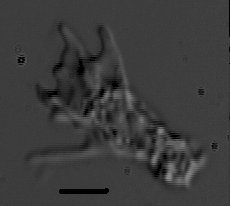
|
|
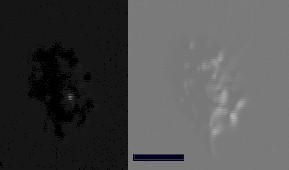
|
|
Left; A floating Mayorella, Middle-left;
Locomoting trophozoite Bar=10mm, Right;
Pair - Birefringence photograph showing bright spot (crystal?), right the
same living amoeba under Hoffman optics(Bar=10mm).
|
 VideoMay2.avi VideoMay2.avi
|
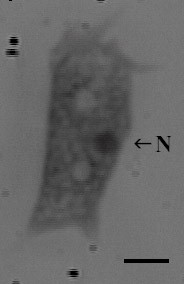
|
Left a stained specimen.
|
 Mayorella
at the Protist Information Server Mayorella
at the Protist Information Server
|
|
This specimen above was isolated from Yellowcraigs beach,
S.E. Scotland. The overall morphology of this species seems to resemble Korotnevella
nivo (Smirnov, 1996/7),
a disputed genera that may or may not eventually belong to Mayorella
(see above). The specimen below were found in an old fountain in
Edinburgh rich in algae, the species is not known. The amoeba below,
left is demonstrating typical pseudopod formation with cone shaped
structures arising from blunter bases. Mayorella from both
marine and freshwater seem to be not very adherent to glass or plastic
(polystyrene) especially when well fed.
|
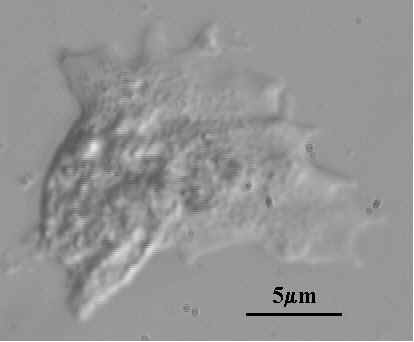
|
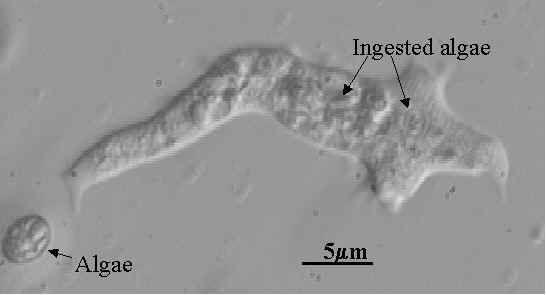
|
|
|
| Described species:-
|
| M. bigemma
100-150
mm in
length |
| M. cantrabrigiensis
|
| M. conipes
(Sawyer,
1975) |
| M. corlissi
(Sawyer,
1975) |
| M. gemmifera |
| M. kuwaitensis |
| M. riparia |
| M. smalli
(Sawyer,
1975) |
| M. vespertiliodes |
| M. viridis
Contains symbiotic algae (giving it its colour and name) 90-160mm
in length, 200nm thick cuticle. |
|
| Available strains:- |
| M. cantrabrigiensis
CCAP 1547/7 (Page, 1981).
Freshwater botanic gardens Cambridge, England. |
| M. cantrabrigiensis
CCAP 1547/11 (Page, 1981).
Freshwater botanic gardens Cambridge, England |
| M. gemmifera CCAP
1547/8 (Page, 1981).
Marine Sheringham, Norfolk, England |
| M. gemmifera CCAP
1547/12 (Page, 1981).
Marine Sheringham, Norfolk, England |
| M. kuwaitensis
CCAP 1547/9 (Page, 1982).
Marine Kuwait, England |
| M. vespertiliodes
CCAP 1547/10 (Page, 1981).
Freshwater, Pond Cambridge England |
| M. viridis CCAP
1547/4 (George, 1966).
Freshwater Goonhilly Down, Cornwall, England |
|
|
| References:-
Page, F.C.
(1983). "Marine Gymnamoebae." Inst.Terr.Ecol. NERC Cambridge,
England.
Sawyer, T.K. (1975). "Marine amoebae from
surface waters of Chincoteaque bay, Virginia : Two new genera and nine
species within the families Mayorellidae, Flabellulidae, and
Stereomyxidae." Trans.Amer.Microscop.Soc. 94(1),
71-92.
Smirnov, A.V. (1996/7). "Two new species
of marine amoebae: Hartmannella lobifera n.sp. and Korotnevella
nivo n.sp. (Lobosea, Gymnamoebida)." Arch. Protistenkd. 147,
283-292.
|
|
